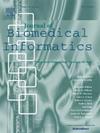将WSI和基因组数据整合到癌症生存预测中的基于注意力的框架。
IF 4.5
2区 医学
Q2 COMPUTER SCIENCE, INTERDISCIPLINARY APPLICATIONS
引用次数: 0
摘要
目的:肿瘤生存预测对加强医疗决策、优化患者管理具有重要意义。准确的生存估计使医疗保健提供者能够制定个性化的治疗计划,改善治疗结果,并识别高风险患者进行及时干预。然而,现有的方法往往依赖于单模态数据或计算过于复杂,限制了它们的实际应用和多模态集成的全部潜力。方法:为了解决这些挑战,我们提出了一个新的多模态生存预测框架,该框架集成了全幻灯片图像(WSI)和基因组数据。该框架采用注意机制对模态内和模态间的相关性进行建模,有效地捕获模态内部和模态之间的复杂依赖关系。此外,应用位置敏感散列优化自关注机制,在保持预测性能的同时显著降低了计算成本,使模型能够高效地处理大规模或高分辨率的WSI数据集。结果:在TCGA-BLCA数据集上的大量实验验证了该方法的有效性。结果表明,与单峰方法相比,整合WSI和基因组数据可以提高生存预测的准确性。优化后的自关注机制进一步提高了模型效率,使其能够在大型数据集上实现。结论:该框架利用多模态数据集成和优化的关注机制,为癌症生存预测提供了一个稳健、高效的解决方案。这项研究强调了多模式学习在医学应用中的重要性,并为人工智能驱动的临床决策支持系统的未来发展提供了一个有希望的方向。本文章由计算机程序翻译,如有差异,请以英文原文为准。

An attention-based framework for integrating WSI and genomic data in cancer survival prediction
Objective:
Cancer survival prediction plays a vital role in enhancing medical decision-making and optimizing patient management. Accurate survival estimation enables healthcare providers to develop personalized treatment plans, improve treatment outcomes, and identify high-risk patients for timely intervention. However, existing methods often rely on single-modality data or suffer from excessive computational complexity, limiting their practical application and the full potential of multimodal integration.
Methods:
To address these challenges, we propose a novel multimodal survival prediction framework that integrates Whole Slide Image (WSI) and genomic data. The framework employs attention mechanisms to model intra-modal and inter-modal correlations, effectively capturing complex dependencies within and between modalities. Additionally, locality-sensitive hashing is applied to optimize the self-attention mechanism, significantly reducing computational costs while maintaining predictive performance, enabling the model to handle large-scale or high-resolution WSI datasets efficiently.
Results:
Extensive experiments on the TCGA-BLCA dataset validate the effectiveness of the proposed approach. The results demonstrate that integrating WSI and genomic data improves survival prediction accuracy compared to unimodal methods. The optimized self-attention mechanism further enhances model efficiency, allowing for practical implementation on large datasets.
Conclusion:
The proposed framework provides a robust and efficient solution for cancer survival prediction by leveraging multimodal data integration and optimized attention mechanisms. This study highlights the importance of multimodal learning in medical applications and offers a promising direction for future advancements in AI-driven clinical decision support systems.
求助全文
通过发布文献求助,成功后即可免费获取论文全文。
去求助
来源期刊

Journal of Biomedical Informatics
医学-计算机:跨学科应用
CiteScore
8.90
自引率
6.70%
发文量
243
审稿时长
32 days
期刊介绍:
The Journal of Biomedical Informatics reflects a commitment to high-quality original research papers, reviews, and commentaries in the area of biomedical informatics methodology. Although we publish articles motivated by applications in the biomedical sciences (for example, clinical medicine, health care, population health, and translational bioinformatics), the journal emphasizes reports of new methodologies and techniques that have general applicability and that form the basis for the evolving science of biomedical informatics. Articles on medical devices; evaluations of implemented systems (including clinical trials of information technologies); or papers that provide insight into a biological process, a specific disease, or treatment options would generally be more suitable for publication in other venues. Papers on applications of signal processing and image analysis are often more suitable for biomedical engineering journals or other informatics journals, although we do publish papers that emphasize the information management and knowledge representation/modeling issues that arise in the storage and use of biological signals and images. System descriptions are welcome if they illustrate and substantiate the underlying methodology that is the principal focus of the report and an effort is made to address the generalizability and/or range of application of that methodology. Note also that, given the international nature of JBI, papers that deal with specific languages other than English, or with country-specific health systems or approaches, are acceptable for JBI only if they offer generalizable lessons that are relevant to the broad JBI readership, regardless of their country, language, culture, or health system.
 求助内容:
求助内容: 应助结果提醒方式:
应助结果提醒方式:


